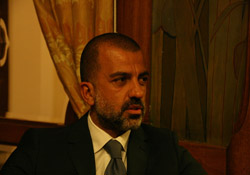Building a coordinated response to migration in Sicily

WHO
Mr Francesco Bongiorno lives in Sicily and works as migration advisor to the Regional Health Councilor. Here, he shares his experiences – in his own words – of working on improving a coordinated response to the needs of newly arrived migrants and refugees.
Migrants have been arriving to the island of Lampedusa [south of Sicily] since 1983. Thousands of migrants arrived there; some occasionally landed in the district of Ragusa on Sicily. Sometimes the ships sank before making it to Italy, but no one outside of Lampedusa or Sicily seemed to notice. Everything changed after the “Lampedusa boat disaster”, as the press called it, in October 2013. This was a massive migrant shipwreck. A few survivors were rescued, and more than 300 dead bodies were recovered.
After this episode, people started to realize what had been happening in the Strait of Sicily. Images of bodies trapped 40 meters below water on the seabed appeared in the press. The Pope visited and said it was urgent to stop the deaths at sea. People started to express indignation over what was happening. This prompted the first humanitarian operation called "Mare Nostrum”.
Today all the ports of landing in Sicilian districts are involved in the management of migration. We no longer see 100 to 200 people arriving at a time; we see thousands arriving with each landing. This affects the whole island.
Following – and building upon – the Lampedusa model
Over the years, the Lampedusa model for receiving migrants has been considered a flagship internationally. It consists of a triage, implemented first by Dr Pietro Bartolo and then later by the Local Health Unit of Palermo district in Sicily. The aim of the triage was first to identify all people who had serious diseases or conditions to report, with “red code” individuals sent immediately to hospitals. In Lampedusa, they used a rescue helicopter; in Sicily, we use ambulances. We have now replicated the Lampedusa model in all the districts of Sicily.
One of our best results, to date, is a contingency plan we developed with the support of WHO/Europe, where we put down on paper who is responsible for what. But since migration is a dynamic event, we cannot stop at the first draft. The plan must be continually reviewed because the priorities keep evolving. Plans that are too rigid will eventually stop being relevant because things change all the time.
Sharing good practices across countries
There is a powerful synergy between the people who manage migration here in Sicily – the police, doctors, Local Health Units, NGOs, non-profits. We have experience that has been acquired on a daily basis since 2013, and during that time we have had 300 000 arrivals. That means triage on the dock for 300 000 people, data from 300 000 people that we can make available to the whole world.
We have perhaps unconsciously developed good practices that can be applied internationally. But we have neither the means nor the ability to amplify these practices. Only WHO has the ability to do this. My dream is that all countries from Spain to Turkey will be linked through a health network, to share best practices and important lessons learned. After all, what happens in Greece is not different from what happens in Sicily, so we should have a consistent model for all of us.



